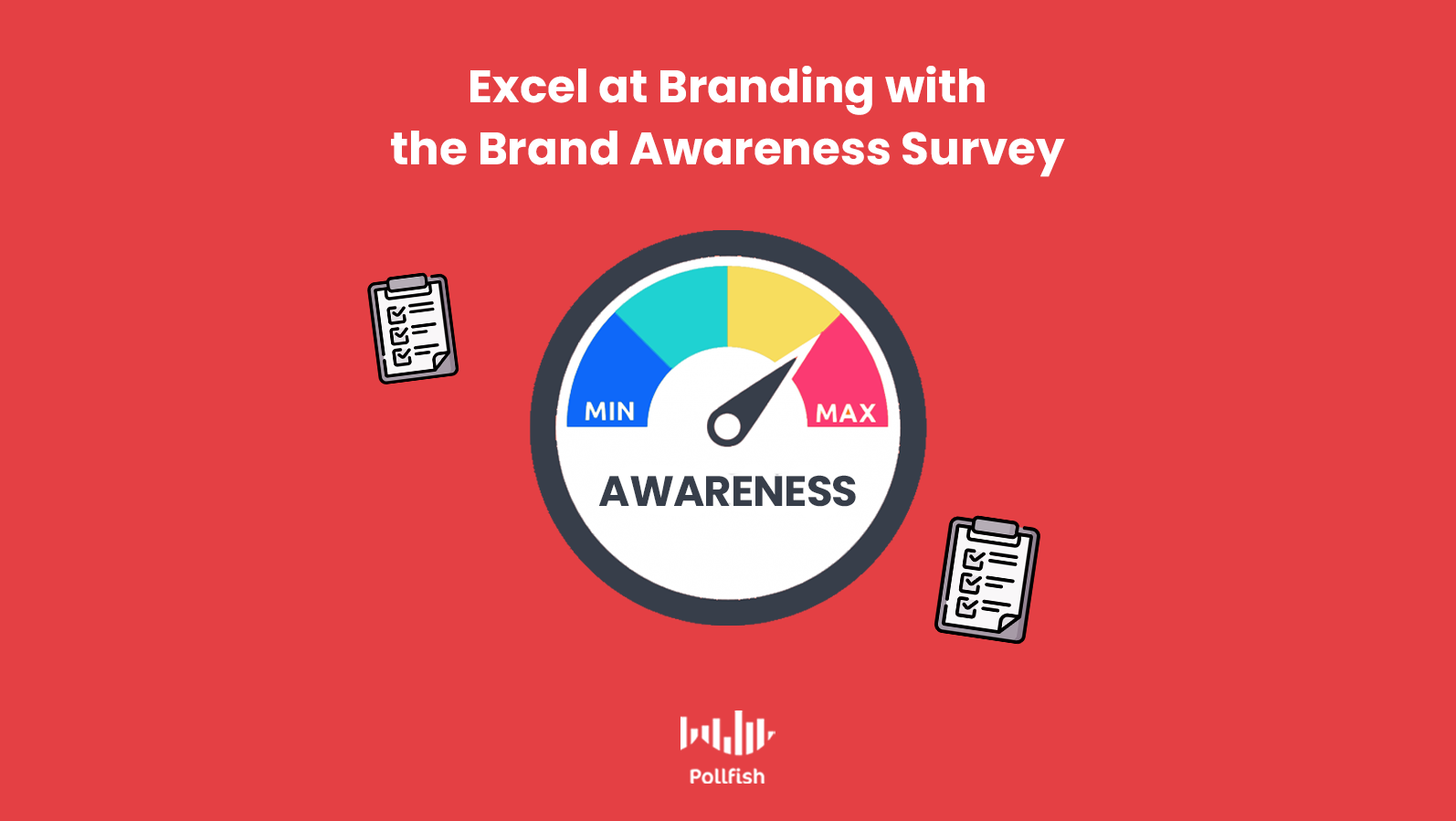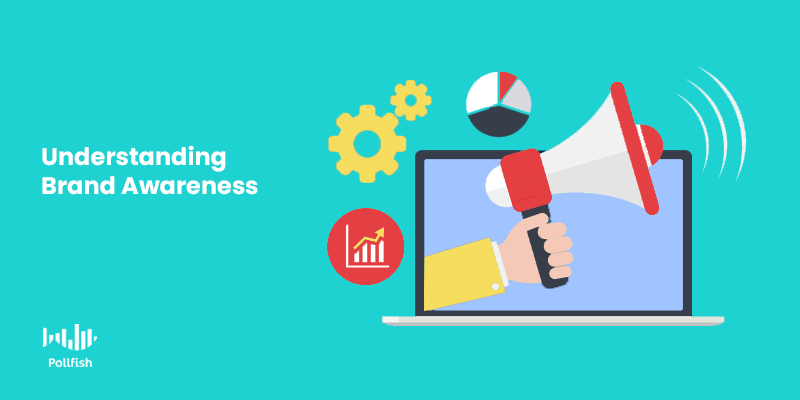Diving Into the Brand Awareness Survey to Excel in Branding

The brand awareness survey is an essential tool to gauge how well members of your target market and others recognize your brand.
It is often a starting point in the practice of branding, a key marketing concept that involves shaping how the public views your brand and what they associate it with.
Brand awareness initiatives are immensely important, as building brand awareness across platforms can raise revenue by 23%. However, consumers won’t immediately remember a brand; it takes consumers 5-7 impressions to remember a brand.
This article explains the brand awareness survey, its utility in the major types of brand awareness, along with how to create one and its overall role in branding market research.
Defining Brand Awareness
Brand awareness is the extent to which a brand is recognized by consumers in its target market and is associated correctly with its offerings.
Brand awareness cannot be measured with a single metric; rather it deals with two major concepts (see the section on types) that can be assessed in several ways.

Brand awareness deals with product/ service recognition with the correct brand in numerous scenarios. For example, one of the concerns marketers face is the question of whether their brand is the first that comes to the minds of consumers when they need to buy something.
If yes, then such a brand has a strong brand awareness. This ties into the idea of visibility; when consumers are keenly aware of brands and constantly have them on their mind. Brand awareness campaigns help foster visibility via various presentation efforts. A consistent brand awareness increases revenue by 33% through presentation.
Defining the Brand Awareness Survey
A brand awareness survey is one of the most potent tools marketers can use to get a sense of their brand awareness. Since brand awareness cannot be clearly defined by individual metrics, this kind of survey is especially useful, as it crunches the numbers on the magnitude of a business’s brand awareness.
This is because the kind of tool is largely a quantitative survey, given that it measures awareness through yes or no questions, along with multiple-selection and single-selection multiple-choice questions.
The function of this kind of survey is to quantify a variety of awareness-related factors, including:
- who knows about your brand
- particular segments of your target market, which you can use for market segmentation
- what they know about your brand
- how much they know
- how they have heard about you
- what your brand is associated with
- This is especially important for brand-building as it makes consumers replace common nouns with a particular brand. Ex: Google for searches, Poland Spring for water.
Unlike other brand awareness measurement tools and methods, surveys have the unique edge of capturing demographic the information of participants. With this data on hand, you’ll understand which segments of your target market your brand resonates with the most.
Additionally, you’ll have a more comprehensive analysis of how well your customer base knows your brand and how you can improve your positioning in your niche.
The Importance of the Brand Awareness
Brand awareness is important on several fronts. Firstly, when someone is aware of your brand, they are already set within your sales funnel — at the earliest stage — but at the sales funnel nonetheless.
This means that when you’ve garnered a healthy brand awareness, many customers in your target market have already begun their buying journey.
Brand awareness is a must to push potential customers further down the funnel to reach the coveted purchase stage. Before customers convert, the various other stages fuel their decision-making. Without brand awareness, it is impossible to drive interest, evaluation and intent to buy.
The following explains the other key points of the importance of building brand awareness:
- It enables your brand to be recognizable under different circumstances and conditions.
- It creates associations between your brand and everyday matters such as:
- Actions
- Products
- Things
- It allows you to target different segments accordingly when you know their brand awareness levels.
- It lets you prioritize your marketing and market research needs.
- It informs you how to allocate marketing resources and funds based on the level of awareness among different groups.
- It is responsible for keeping your brand on top of your target market’s minds.
- It drives performance-marketing goals, including leads and sales.
- Ex: Boxed.com, an ecommerce site, increased its brand awareness through an earned media partnership, which raised its conversion rate by 3.18%.

The Two Types of Brand Awareness
Brand awareness occurs in two main forms: brand recognition and brand recall. It is crucial to understand both, as being able to do so will allow you to build effective survey studies for brand awareness.
This is because these two concepts are the chief makeup of brand awareness and in order to tackle this campaign effectively, it is crucial to be able to understand the two categories. In addition, the categories allow you to better organize your efforts.
Brand Recognition (Aided Research)
This refers to the ability of customers to recognize your brand when they also view others, including your competitors.
The brand recognition aspect of awareness is crucial when customers are presented with a variety of product choices at once, for example, when they are at a store or at an online marketplace that sells the same products from various brands.
In this instance, it is ideal for your brand to have a “top of mind” selection status. Customers are more likely to buy a brand they already know, unless they’ve had a terrible experience with it. When customers have a level of familiarity with your brand, they will be more inclined to purchase from it when presented with the same or even similar products from other brands.
Newer companies who have not established their brand in their markets ought to focus their brand awareness efforts on brand recognition, as people are generally more comfortable with choosing something they already know, rather than opting for uncharted territory.
Brand Recall (Unaided Research)
Brand recall refers to the studies that measure the ability of customers to bring the name of your brand to mind without seeing it on a list first.
When it comes to brand awareness surveys, this means you need to use open-ended questions, particularly those with the “other” option. For example, let’s say you ask if the respondent knows any of the brands in a list, thereby using a multiple-selection question.
If your brand has high brand recall levels, the respondents will choose “other” and type in the name of your brand in the open-ended field.
This method grants you higher quality data in that these kinds of questions have a higher “hurdle” than do aided research questions. This is also because an unaided study yields higher consumer preference than an aided study.
How to Create a Brand Awareness Survey
In order to create a brand awareness survey, you ought to first narrow down your needs. To do so, consider this: do you need to measure brand awareness to gain a general sense of your brand awareness, or to measure it in conjunction with another campaign (ex: advertising).
If you need to measure brand awareness in the general sense: choose whether to begin with a brand recall or brand recognition survey. Or, merge both into one survey. This will differ from brand to brand; as aforesaid, newer brands may want to invest in brand recognition studies.
Incorporate the following questions into a brand recall survey:
- When you think about [insert industry/niche], which brands come to mind first?
- List up to 5 open-ended field questions
- When you think of [product], what brand or brands come to your mind?
- Open-ended question field
- Which brands do you know the most about/
- List up to 5 open-ended field questions
- How open would you be to trying new brands in [industry/niche/product category]?
- Use a Matrix scale or scaled multiple choice answers
- Name your 5 go-to brands for [product/service/industry category].
- List up to 5 open-ended field questions
Incorporate the following questions into a brand recognition survey:
- Which of the following brands of [product/service type] have you heard of?
- The answers should be names of such brands listed in either a single-selection answer or multiple-selection answer.
- Have you heard of [brand name]?
- How familiar are you with [brand name]?
- When was the first time you heard about [brand name]?
- Multiple-choice, with an open-ended “other” option
- Where have you seen/ heard about [brand] recently? (Select all that apply)
- Multiple-selection answers
If you need to measure brand awareness with another marketing or market research campaign: choose whether to begin with a survey on your campaign separately from a brand awareness survey, in conjunction with one or to merge the two concepts into one survey.
Then choose whether you need to measure brand recognition or brand recall. Use the above questions together, or in separate surveys for your joint survey study. Make sure to ask questions that deal with specific actions you’ve taken in your other campaign to see how they have contributed to your brand awareness levels.
Brand Awareness Questions for Joint Campaigns:
- Have you seen this ad? (Include media file with the ad)
- Yes or no
- Does this ad make you want to buy from [brand]?
- Scaled answers (Ex: I’m not sure, I’d like to learn more)
- Does this brand remind you of any others? (for competitive analysis)
- Yes or no
- List up to 5 open-ended field questions if yes
- Does this quote remind you of any brands?
- Yes or no
- List up to 5 open-ended field questions if yes
- If this commercial didn’t convince you, what may strike your interest/memories with this brand?
- Open-ended field
The Need for the Brand Awareness Survey in Branding
It’s important to invest in brand awareness, as it associates actions and products with specific brands. This incites members of your target market to replace common words with branded ones subconsciously.
In turn, the customers naturally search for particular brands when completing their shopping needs and buy from those brands. The brand awareness survey is a critical tool for helping brands reach this level of customer consciousness by measuring the degree of brand awareness.
Given that researchers can ask virtually any question, they can form a questionnaire that reaps insights on both brand recall and brand recognition, guiding the studies of both.
Furthermore, brands can run these surveys continually, from the inception of their business to implementing market research techniques, to running experimentations and surveys that deal with other key business aspects such as advertising and product testing. The most critical component of running these survey campaigns is a viable online survey platform. Such a platform should facilitate survey creation, launches and analyses, along with making it easy to screen respondents and create the relevant question types for measuring brand awareness.
Pollfish Marketing Team
Ready to Try Pollfish?
Create your survey with AI, target high-quality respondents starting at $0.95 per complete, and start getting results in just minutes in real-time. From running a simple product concept survey to managing a constant stream of trackers for dozens of clients in dozens of countries, we’ve got you.
